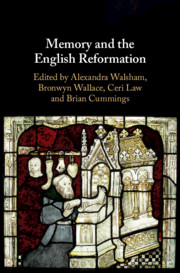Book contents
- Memory and the English Reformation
- Memory and the English Reformation
- Copyright page
- Dedication
- Contents
- Figures
- Contributors
- Preface and Acknowledgements
- Abbreviations
- Introduction
- Part I Events and Temporalities
- Part II Objects and Places
- 7 Dolls and Idols in the English Reformation
- 8 Monuments and the Reformation
- 9 Memorable Motifs
- 10 Revitalising Antiquities
- 11 Rereading Ruins
- 12 ‘Monuments of Our Indignation’
- Part III Lives and Afterlives
- Part IV Rituals and Bodies
- Index
8 - Monuments and the Reformation
from Part II - Objects and Places
Published online by Cambridge University Press: 30 October 2020
- Memory and the English Reformation
- Memory and the English Reformation
- Copyright page
- Dedication
- Contents
- Figures
- Contributors
- Preface and Acknowledgements
- Abbreviations
- Introduction
- Part I Events and Temporalities
- Part II Objects and Places
- 7 Dolls and Idols in the English Reformation
- 8 Monuments and the Reformation
- 9 Memorable Motifs
- 10 Revitalising Antiquities
- 11 Rereading Ruins
- 12 ‘Monuments of Our Indignation’
- Part III Lives and Afterlives
- Part IV Rituals and Bodies
- Index
Summary
This chapter investigates how the Reformation has been remembered through English monuments. It outlines the development of early modern tombs to individuals and families which both reflected and shaped Protestant theories of death and memories of the Reformation. It describes the emergence of memorials to the Reformation as a specific event in the nineteenth and twentieth centuries, focused on the commemoration of Protestant and Catholic martyrs. The chapter concludes that the commemoration of the Reformation in memorials has almost always been contentious and sectarian, notwithstanding some recent ecumenical examples, and proposes that future monuments acknowledge a shared history of suffering to enact reconciliation.
- Type
- Chapter
- Information
- Memory and the English Reformation , pp. 168 - 184Publisher: Cambridge University PressPrint publication year: 2020

